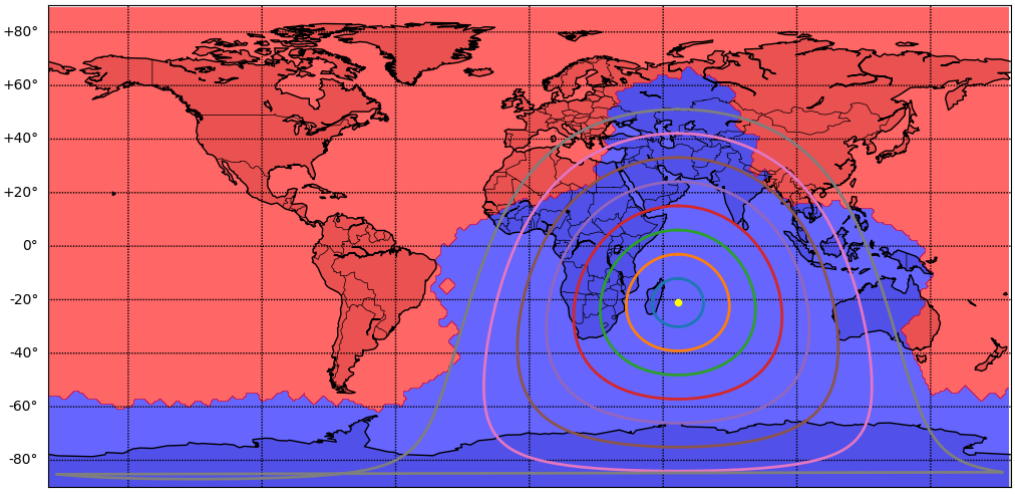La Réunion EU MEOLUT, a cornerstone new infrastructure for SAR Galileo delivery in the Indian Ocean

From 1982 to 2022, 40 years of lives saved by Cospas-Sarsat
Amidst the celebration of the 40th anniversary of the first use of satellite technologies by Search and Rescue (SAR) forces earmarked on 10 September 1982 as well as the 40th anniversary of uninterrupted SAR operations of the French Mission Control Center (FMCC), the SAR/Galileo is enlarging its contribution to the Cospas-Sarsat (C/S) system of international SAR efforts cooperation with a fourth MEOLUT (Medium Earth Orbit Local User Terminals) facility deployed in the Indian ocean La Reunion island.
SAR/Galileo Services were designed to support the Cospas-Sarsat (C/S) in the context of the MEOSAR system (Medium Earth Orbit Search And Rescue) providing uninterrupted Search and Rescue services globally which account for more than 2,000 lives saved a year.
Galileo is already the largest ground (in terms of MEOLUTs) and space segment (L-band SAR payloads) provider within C/S in addition to being the only offering exclusively the Return Link Service (RLS).
Galileo SAR MEOLUTs Key Components of the SAR Ground Segment
La Reunion/ EU MEOLUT facility has been installed in an Orange Site at Rivière-Des-Pluies in the French La Reunion island in close vicinity of a combined Uplink Station (ULS) and Ground Sensor Station (GSS) existing Galileo remote site. The new MEOLUT successfully passed the required C/s commissioning tests and started providing operational alert data to the French Mission Control Center (FMCC) in a coverage area equivalent to a circle of a radius of 2,500 km for the first-generation C/S beacons and ELT(DT) detection coverage area of a radius of 6,000 km.
Further to the commissioning activities already performed, the MEOLUT is soon to undergo a dedicated SAR/Galileo service validation phase before fully being an integral part of the SAR/Galileo Ground Segment and becoming the fourth EU MEOLUT joining the three already operational located in Larnaca (Cyprus), Maspalomas (Spain) and Spitsbergen (Norway).
Galileo instrumental to achieve Cospas-Sarsat global Coverage including ELT(DT) beacon detection and distribution.
The Galileo SAR Programme continue to strive in providing world-class Search and Rescue services, the addition of the fourth MEOLUT facility in the Indian Ocean will underpin the efforts to achieve the Cospas-Sarsat MEOSAR global coverage but also ensure that C/S meets the ICAO deadline for the provision of a Global Aviation Distress and Safety System (GADSS) Automatic Distress Tracking capabilities in aircraft through ELT(DT) beacons.
The following figure illustrates the contribution of the SAR/Galileo la Réunion MEOLUT, represented in a yellow dot while the blue colour represents detection compliance status.
La Réunion EU MEOLUT Service Coverage Area
The case in point: First Return Link Distress Alert under the Coverage of the new SAR Galileo MEOLUT
As we commemorate the anniversaries of C/S, FMCC and the new SAR/Galileo MEOLUT, the 1st Return Link Service distress alert was recorded by Galileo coincidentally within the area of coverage of the newly inaugurated SAR/Galileo MEOLUT.
On 18 November, the Asteria, an 11m sailing boat captained by Helsinki life-long skipper Tapio Lehtinen, competing in the Golden Globerace noticed a strong unidentified water intake from astern. Tapio had only time to put on his survival suit, grab the grab-bag and jump into open seas with the liferaft, where at 8h 44min 44sec activated his SAR/Galileo Return Link PLB and saluted the Asteria for the last time as she was sinking.
Media note: This feature can be republished without charge provided the European Union Agency for the Space Programme (EUSPA) is acknowledged as the source at the top or the bottom of the story. You must request permission before you use any of the photographs on the site. If you republish, we would be grateful if you could link back to the EUSPA website (http://www.euspa.europa.eu).
EU Agency for the Space ProgrammeRead More


